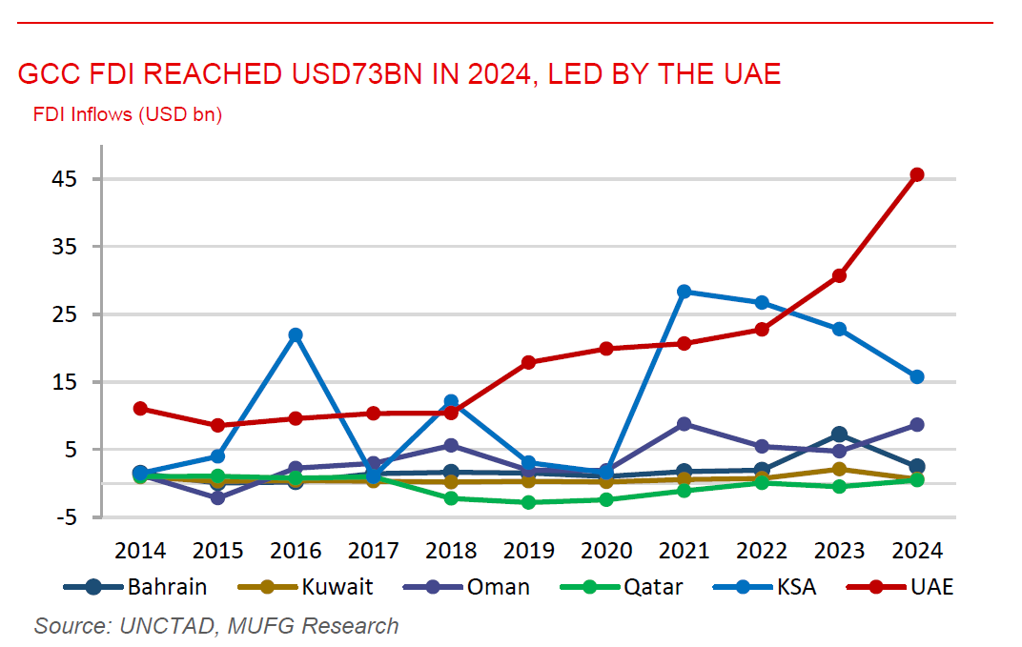To read the full report, please download the PDF above.
Middle East Daily
SOOJIN KIM
Research Analyst
DIFC Branch – Dubai
T: +44(4)387 5031
E: soojin.kim@ae.mufg.jp
MUFG Bank, Ltd. and MUFG Securities plc
A member of MUFG, a global financial group
Middle East Daily
COMMODITIES / ENERGY
Oil holds steady as markets await Trump-Putin talks and OPEC data. Oil prices were little changed, with Brent near USD67/b and WTI around USD64/b, as investors weighed President Trump’s extension of a tariff truce with China to November 10 against uncertainty over this upcoming meeting with President Putin, which could influence sanctions and supply flows. Crude remains near two-month lows, down over 10% this year amid OPEC+ reversal of 2023 supply cuts and slowing global growth. Trading volumes in Brent fell to their lowest since early July, reflecting cation ahead of key OPEC and US DOE reports due today. Meanwhile, Chinese refiners have reduced September crude nominations from Saudi Aramco to 43 million barrels from 51 million a month earlier. The shift highlights potential reordering in global crude glows as US and EU pressure India over Russian oil imports, possibly redirecting more Russia supplies to China.
Gold steadies after Trump’s pledges no tariffs on gold. Gold held near USD3,350/oz after falling yesterday when President Trump declared that gold imports would not face US tariffs, easing market panic sparked by a US Customs and Border Protection ruling last week that initially suggested duties would apply. The surprise decision had briefly sent New York futures over USD100 above London spot prices, though the spread has now narrowed to about USD50. Traders remain cautious, awaiting formal policy clarification, as the ruling could have major implications for global gold flows and US futures market stability. Gold is still up over 25% this year, driven largely by early-2025 geopolitical and trade tensions and strong central bank buying.
MIDDLE EAST - CREDIT TRADING
End of day comment – 11 August 2025. It’s actually called Pahoehoe lava—the slow-moving kind you could almost get close to (though still dangerously hot), unlike the fast, dramatic lava in action movies. That’s what the market feels like now: steady and slow, but risky if approached carelessly. Similar to Friday, cash prices were largely unaffected by underlying rate moves across most names, with a tendency to tighten. LT2 bonds caught a bid last week, and today RJHIAB AT1s rose about ¼ point, raising the question of whether BSFR and ALBIAB might be next. Benchmark bonds remain well bid, with demand also for 5- and 10-year KSA corporates and financials. Overall, supply is scarce—apart from Qatar—with other names simply lacking strong demand. Unlike Friday, there were some prints in Bahrain, while Turkish corporates and financials, heading into earnings season, are gradually grinding higher with 5–10 bonds up ¼ to ½ point. Covering Dom’s book this week, the only consistent supply observed has been in the Qatar complex, mostly shorter-dated bonds, with a notable index-driven exodus.
MIDDLE EAST - MACRO / MARKETS
Saudi Arabia’s industrial output hits 3-year high on oil boost. Saudi Arabia’s industrial production jumped 7.9% y/y in Q2 2025, marking its fastest growth in nearly three years, as manufacturing activity strengthened and oil output rebounded under a looser OPEC+ supply policy. Data from the General Authority for Statistics showed the expansion was broad-based across mining, quarrying, manufacturing, and public utilities such as electricity, gas, and water supply. The pickup in industrial activity aligned with a 4% GDP increase in the same quarter, driven by steady gains in the non-oil economy and renewed growth in oil activities after a first-quarter contraction. The Kingdom’s oil sector returned to expansion as it ramped up production following years of output restraint, benefiting from recent OPEC+ decisions to boost supply. While the stronger performance supports Vision 2030’s diversification goals, Saudi Arabia remains highly depended on energy revenues. IMF estimates the fiscal breakeven oil price at USD92.3 reflecting the pressure to maintain high oil prices to fund economic momentum and large-scale investment projects.
UAE tops Global Greenfield FDI Performance Index for second year. The UAE ranked first worldwide in the 2025 Greenfield FDI Performance Index with a score of 14.3 (out of 105 countries), maintaining its global lead from 2024 by attracting more foreign investment relative to its economic size than any other country. Across the Middle East, five other nations also outperformed their share of global GDP in securing inward greenfield FDI last year. Bahrain emerged as the region’s strongest overperformer with an index score of 5.8, buoyed by strong interest from financial, business, and software service companies positioning it as a hub for regional growth. Bahrain recorded 31 FDI projects in 2024, its highest since 2017. Qatar (4.7), Oman (2.4), Saudi Arabia (2.0), and Jordan (1.8) also exceeded expectations, while Kuwait (0.8) and Israel (0.2) underperformed relative to economic size.

